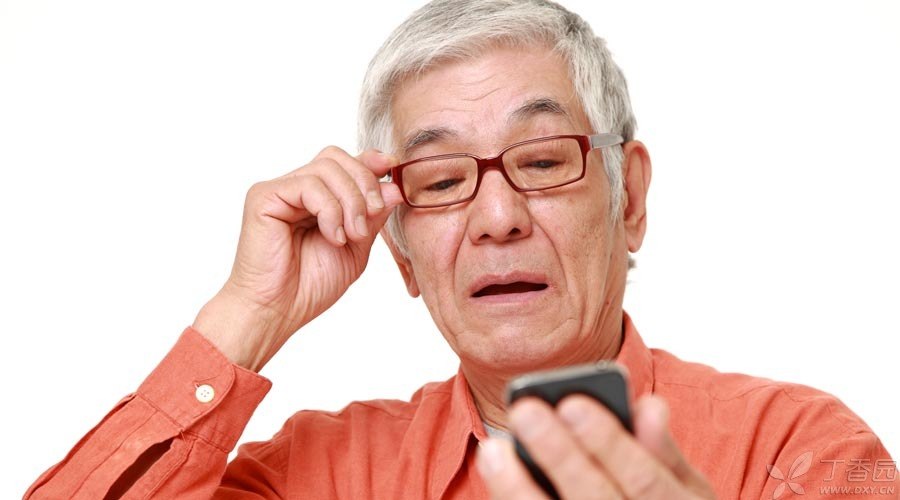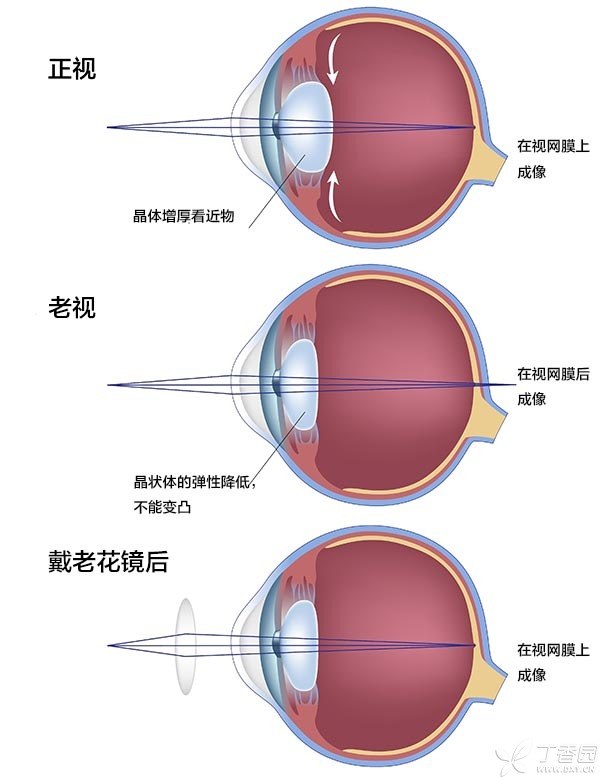
Forty years old, Fifty knows destiny. If psychological maturity is added to a healthy life, Modern people in their 40s and 50s can not only be comfortable in life and work, You can live like 18 years old with vigor and vitality. However, there are always some clues that reveal the secret of your age, such as unconsciously taking your mobile phone away from you, silently setting your mobile phone font to a larger size, and not being able to see the words on the drug instructions in a slightly dim place … These are manifestations of presbyopia.
Speaking of which, there may have been many people lying down with their guns, feeling that they cannot refuse to accept the old age. However, there are always some people who are not satisfied with their old age. They regard presbyopia as a personal feud and swear to understand it.
Which manifestations suggest presbyopia?
1. Looking at small characters from the usual distance, there are double images or they cannot be seen clearly;
2. Unconsciously tilt your head back or take the reading to a further place when reading at close range;
3. Close reading requires brighter lighting;
4. It can’t last long. After a long time, eyes will swell, eyes will be sore, and even headache and dysphoria will occur.
If a 50-year-old person does not have any of the above manifestations, it does not mean that he does not have presbyopia, but he has not developed symptoms.
What is presbyopia?
Presbyopia, medically known as presbyopia, is essentially a decline in the physiological regulation function of the eyes. Generally, presbyopia begins to appear after the age of 45, which is a necessary physiological process in everyone’s life.
If the eye is compared to a camera, presbyopia means that the focusing function of the camera decreases until it disappears.
The human eye mainly relies on the lens to focus: when looking far away, the lens flattens and is in a state of adjustment and relaxation; When looking near, the lens becomes convex, increasing the refractive ability of the lens and converging the divergent light from nearby objects on the bottom plate.
With age, the elasticity of the lens decreases and cannot become convex as it did when it was young, so it is imaged behind the retina. At this time, it is necessary to put the near object away or wear a convex lens to see the object clearly.

The degree of presbyopia can generally be expressed by the additional convex lens degree when looking at the near object. With the increase of age, the degree of presbyopia gradually increases, generally according to the speed of deepening 50 degrees every 5 years, usually presbyopia is 300 ~ 350 degrees at most.
Age is undoubtedly the most relevant factor for presbyopia. But age is similar, The degree of presbyopia is also different, in addition to individual physical quality differences, also related to the whole body condition, medication, etc. Suffering from anemia, heart disease, diabetes, multiple sclerosis and other diseases, or long-term use of alcohol, anti-anxiety drugs, antidepressants, antihistamines and other drugs may make presbyopia occur in advance.
Is myopia really not easy to presbyopia?
First of all, it should be made clear that presbyopia is different from presbyopia symptoms. The states are similar and the symptoms can be different. The original eye degree, myopia or hyperopia, may be different.
A, B and C are of the same age. After examination, all three have 150 degrees of presbyopia, but A and C have already felt it is difficult to see close, while B has no performance at all. Let’s see how the three are different.
1. A was originally 100 degree hyperopia
When he was young, A could see clearly from far to near. After the age of 45, it is still no problem to look far away, but looking near is getting more and more tiring. The reason is that farsighted eyes need more adjustment power when looking near than emmetropic eyes. However, presbyopia weakens the adjustment power, and A has obvious difficulties when looking near.
2. B was originally 100 degree myopia and did not wear a mirror.
When he was young, his far vision was less than 1.0 and he did not wear a mirror. After the age of 45, the distant vision has not changed much, and the near vision is still clear. The reason is that myopia needs less adjustment when looking near. Even if presbyopia already exists, the weakened adjustment can still meet the need of looking near, and there is no presbyopia symptom.
3. C is also 100 degree myopia, wearing 100 degree myopia mirror
C and B are also 100-degree myopia. In order to see clearly, they wear a pair of 100-degree myopia glasses. After 45 years old, still need to wear a mirror to see far, wear glasses when looking near will feel tired, take off the glasses to see more comfortable. The reason is that wearing a mirror to correct the original myopia, C still needs the same adjustment force as facing eyes when looking near, and presbyopia makes the adjustment force unable to meet the needs, so it is not clear when looking near, and the situation after taking off the mirror is similar to B.
It can be seen that presbyopia will occur whether myopia, hyperopia or emmetropia. The difference is that myopia may not have obvious presbyopia symptoms, while hyperopia may have earlier and more obvious symptoms.
In addition to the original refractive state, eye habits, living habits and so on will affect the performance of presbyopia. For example, under the similar refractive state and presbyopia degree, an elderly person who likes writing is more likely to feel asthenopia than an elderly person who likes jogging.
Presbyopia, can you be what?
1. Adjust the environment and relieve symptoms
(1) Improve brightness: Presbyopia at the beginning, may just be in the dark can not see clearly. At this time, can enhance the indoor light, and use double lighting, put a desk lamp between the book and the eyes. This can not only increase the contrast of reading, but also reduce the pupil, increase the depth of focus, improve eyesight;
(2) Adjust the font size and color of the reading materials: generally, black and white reading materials are easier to distinguish;
(3) Proper rest: Avoid long-term close reading, so as not to cause eye pain, eye acid and other asthenopia, and pay attention to the combination of near and far.
2. Wear the right glasses to correct your eyesight.
Presbyopia can compensate for the lack of adjustment force by wearing convex lenses. It is recommended to go to regular medical institutions for matching.
(1) Optometry: The matching of presbyopic glasses is carried out on the basis of the original refractive state. First, it is necessary to determine whether the original refractive state is myopia, hyperopia or emmetropia, then it is necessary to determine the degree of presbyopic, and finally the lens worn is to add the degree of presbyopic to the original lens;
(2) Use residual adjustment force: The ideal glasses for presbyopia is to let the wearer use part of his own residual adjustment force. If the lens is used instead of all adjustment force, the self-adjustment system will lose the opportunity to exercise. On the contrary, if all the residual adjusting forces need to be used every time you look close, you will easily feel tired.
(3) Adjust the degree in time: As the age increases, the degree of presbyopia will gradually increase, generally increasing at a rate of 50 degrees every 5 years, and the degree needs to be adjusted accordingly;
(4) Choose the appropriate lens: According to the comprehensive consideration of presbyopia’s refractive state, eye habits, wearing comfort, etc., different lenses such as single focus, double focus, progressive multi-focus, etc. can be selected.
3. Without glasses, there is another way out.
For some people who have never worn glasses when they were young or have already taken them off through surgery, they are often unwilling and unaccustomed to wearing reading glasses again. At this time, surgery provides another way out.
Presbyopia correction surgery is a hot research topic in the field of refractive surgery and is maturing day by day.
Several Common Mistakes
1. Presbyopia is farsightedness
Both presbyopia and hyperopia can be corrected by convex lenses, so they are often mistaken for the same thing. Hyperopia is due to the relatively short axis of the eye, or the refractive power of the refractive components of the eye is weak, resulting in ametropia, which requires convex lenses to be worn when looking far and near. Presbyopia only requires additional convex lenses when looking near.
2. Myopia does not need reading glasses,
Myopia still needs to wear a mirror when looking far, but it may not need to wear a mirror when looking near. This is because myopia is imaged in front of the retina, while presbyopia is imaged behind the retina when looking near, and when the degree of myopia and presbyopia are close, it can be imaged on the retina. However, if the degree of myopia is low and the degree of presbyopia is high, convex lenses still need to be worn when looking close. On the contrary, if the degree of myopia is higher and the degree of presbyopia is lower, the degree of myopia needs to be matched lightly when looking near.
3. The doctor said that my presbyopia is 200 degrees, so I can just buy a pair of 200 degrees presbyopic glasses myself.
The matching of presbyopic glasses needs to add presbyopic degree to the original refractive state. For example, if you have 100 degrees of hyperopia, the presbyopic glasses you need to wear are 300 degrees of convex lenses. For patients with 75-degree myopia, the presbyopic glasses that need to be worn are 125-degree convex lenses. If it is a 500-degree myopia patient, the presbyopic glasses that need to be worn are 300-degree concave lenses. Generally, it is recommended to go to a hospital or a regular store for inspection and matching, and do not buy them casually.
It is also the trace left by the years. Presbyopia is much more complicated. Please consult a professional doctor.
Editor: Fei Fei
Author: Xu Ye
This article is exclusively authorized to be used by Clove Garden and refuses any other form of reprinting.
